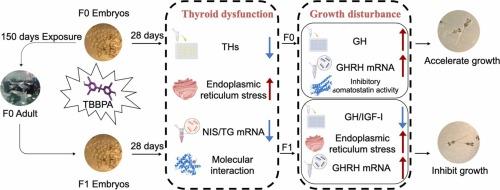Differential developmental effects and its potential mechanism of long-term exposure to TBBPA in two generations of marine medaka (Oryzias melastigma) during early life stages
IF 11.3
1区 环境科学与生态学
Q1 ENGINEERING, ENVIRONMENTAL
引用次数: 0
Abstract
Tetrabromobisphenol A (TBBPA), a most widely used brominated flame retardant, has been detected in worldwide aquatic environments. However, the effects and mechanisms of TBBPA at environmentally realistic levels have not been well characterized in aquatic organisms. This study aims to investigate the impact of TBBPA on developmental toxicity and endocrine system in two generations of marine medaka (Oryzias melastigma) during early life stages. The results revealed that the embryos under exposure to environmentally relevant concentrations of TBBPA (0, 5, 50, and 500 μg/L) resulted in accelerated hatching and growth development in F0 generation. Conversely, delayed hatching, decreased hatch rate, and growth inhibition were observed in the F1 generation. Moreover, TBBPA disrupted the levels of THs (thyroid hormones), GH (growth hormone), and IGF (insulin growth factor). The gene transcriptional profiling implies modified gene expressions in the HPT axis, GH/IGF axis, and endoplasmic reticulum stress. The molecular docking analysis confirmed the binding affinity of TBBPA to key endocrine-related proteins, which partially elucidates the mechanism of endocrine disruption and developmental abnormalities. Endoplasmic reticulum stress may explain the developmental differences between the two generations. This was the first study to explore the multigenerational developmental toxicity of TBBPA to marine fish, which is essential for ecological risk assessment of this emerging pollutant.

长期暴露于TBBPA对两代海洋medaka (Oryzias melastigma)早期发育的差异影响及其潜在机制
四溴双酚A (TBBPA)是一种应用最广泛的溴化阻燃剂,已在世界各地的水生环境中被检测到。然而,在环境现实水平上,TBBPA在水生生物中的作用和机制尚未得到很好的表征。本研究旨在探讨TBBPA对两代海洋medaka (Oryzias melastigma)早期发育毒性和内分泌系统的影响。结果表明,暴露于环境相关浓度(0、5、50和500 μg/L)的TBBPA对F0代的孵化和生长发育均有促进作用。相反,在F1代中,观察到孵化延迟,孵化率降低和生长抑制。此外,TBBPA破坏了甲状腺激素(THs)、生长激素(GH)和胰岛素生长因子(IGF)的水平。基因转录谱表明HPT轴、GH/IGF轴和内质网应激中的基因表达发生了改变。分子对接分析证实了TBBPA与关键内分泌相关蛋白的结合亲和力,部分阐明了内分泌干扰和发育异常的机制。内质网应激可以解释两代之间的发育差异。这是首次探索TBBPA对海洋鱼类的多代发育毒性的研究,这对评估这种新兴污染物的生态风险至关重要。
本文章由计算机程序翻译,如有差异,请以英文原文为准。
求助全文
约1分钟内获得全文
求助全文
来源期刊

Journal of Hazardous Materials
工程技术-工程:环境
CiteScore
25.40
自引率
5.90%
发文量
3059
审稿时长
58 days
期刊介绍:
The Journal of Hazardous Materials serves as a global platform for promoting cutting-edge research in the field of Environmental Science and Engineering. Our publication features a wide range of articles, including full-length research papers, review articles, and perspectives, with the aim of enhancing our understanding of the dangers and risks associated with various materials concerning public health and the environment. It is important to note that the term "environmental contaminants" refers specifically to substances that pose hazardous effects through contamination, while excluding those that do not have such impacts on the environment or human health. Moreover, we emphasize the distinction between wastes and hazardous materials in order to provide further clarity on the scope of the journal. We have a keen interest in exploring specific compounds and microbial agents that have adverse effects on the environment.
 求助内容:
求助内容: 应助结果提醒方式:
应助结果提醒方式:


